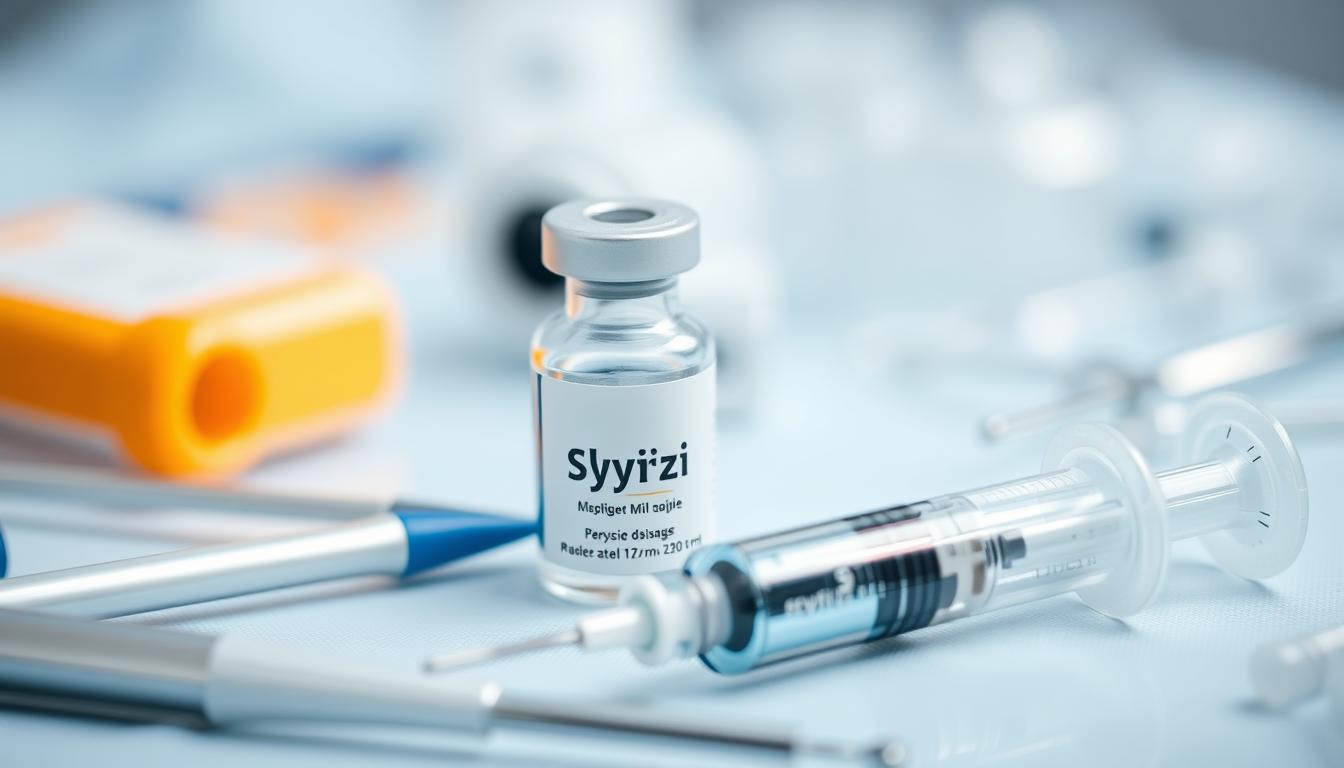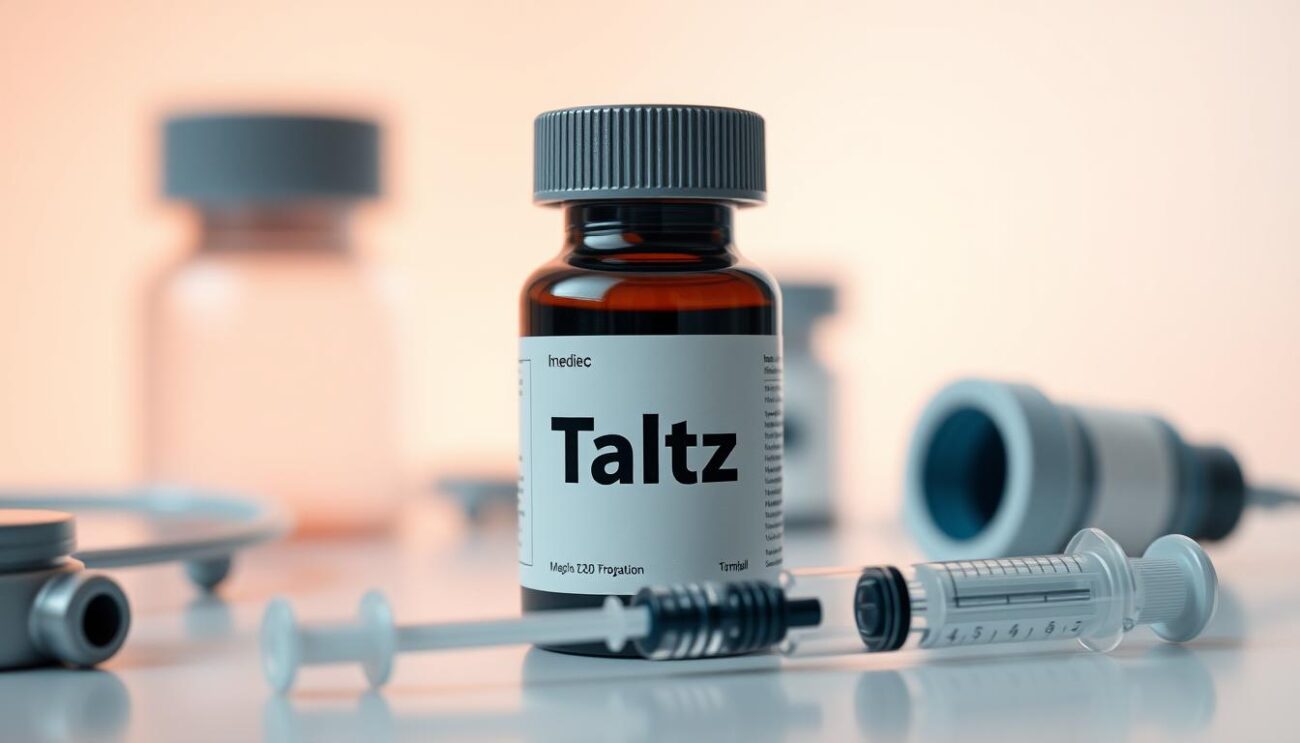Do you live with moderate to severe plaque psoriasis, active psoriatic arthritis, or other chronic conditions? If yes, you might be taking Skyrizi (risankizumab-rzaa). This targeted biologic therapy can help manage your symptoms and improve your life. But do you know how to use it correctly? Skyrizi dosing and administration are key to getting the best results. In this guide, we’ll dive into the details of Skyrizi dosing, from preparation to injection, to help you get the most from this treatment.
Key Takeaways
- Skyrizi is a prescription medication used to treat moderate to severe plaque psoriasis, active psoriatic arthritis, moderate to severe Crohn’s disease, and moderate to severe ulcerative colitis in adults.
- Proper Skyrizi dosing and administration are essential for optimal treatment outcomes.
- Skyrizi is available in various formulations, including prefilled syringes, pens, vials for intravenous infusion, and single-dose prefilled cartridges with on-body injectors.
- Careful preparation, such as allowing the medication to reach room temperature and ensuring the liquid is clear to slightly yellow, is crucial before injection.
- Step-by-step injection instructions, including selecting the appropriate injection site and following the administration schedule, must be followed to ensure the safe and effective use of Skyrizi.
What is Skyrizi?
Skyrizi, also known as risankizumab, is a new drug. The U.S. Food and Drug Administration (FDA) has approved it. It’s a monoclonal antibody that targets a specific pathway in the body.
This pathway, called interleukin-23 (IL-23), is key in some chronic inflammatory diseases. By blocking it, Skyrizi helps manage these conditions.
Skyrizi Uses and Indications
Skyrizi is approved for treating several conditions in adults:
- Moderate to severe plaque psoriasis
- Active psoriatic arthritis
- Moderate to severe Crohn’s disease
- Moderate to severe ulcerative colitis
It works by reducing inflammation. This helps patients with these chronic diseases find relief. Skyrizi is given through injections or infusions, depending on the condition.
| Indication | Dosage | Administration |
|---|---|---|
| Plaque Psoriasis | 150 mg | Subcutaneous injection |
| Psoriatic Arthritis | 150 mg | Subcutaneous injection |
| Crohn’s Disease | 600 mg | Intravenous infusion |
| Ulcerative Colitis | Varies | Subcutaneous injection or intravenous infusion |
Skyrizi is a versatile treatment for several immune diseases. It’s a valuable option for doctors and patients. Knowing how it’s used helps patients and doctors decide if it’s right for them.
Important Safety Considerations
When it comes to Skyrizi, safety is key. This drug can cause serious side effects like severe allergic reactions and a higher risk of infections. It’s important for patients to check for tuberculosis (TB) and any active infections before starting Skyrizi.
Patients should not get live vaccines while on Skyrizi because it may raise the risk of infection. It’s crucial to tell your healthcare provider right away if you have signs of infection like fever, chills, cough, or shortness of breath.
Also, if you’re allergic to risankizumab-rzaa or any part of Skyrizi, you should not take it. There have been reports of anaphylaxis, a serious allergic reaction, with Skyrizi treatment.
The risk of infection goes up with Skyrizi treatment. There have also been cases of drug-induced liver injury in patients with Crohn’s disease during the induction phase of Skyrizi. In psoriatic arthritis trials, Skyrizi was linked to more liver problems than the placebo.
It’s important for patients to know about these possible side effects. They should work closely with their healthcare providers to watch their condition and any changes during treatment.
skyrizi dosing
Managing chronic conditions like plaque psoriasis and psoriatic arthritis is crucial. The right skyrizi dosage and how to take it can greatly help. Skyrizi, a biologic medication, is approved by the FDA for these conditions.
The skyrizi dose for treating plaque psoriasis and psoriatic arthritis is 150 mg. This is given by subcutaneous injection at weeks 0, 4, and every 12 weeks after. For Crohn’s disease and ulcerative colitis, a higher dose of 600 mg is given by intravenous infusion first. Then, the 150 mg subcutaneous dose is used for maintenance.
Healthcare providers must follow the skyrizi recommended dosage carefully. This ensures the medication is used correctly. It helps in getting the best results and reduces the chance of side effects.
| Condition | Initial Dose | Maintenance Dose |
|---|---|---|
| Plaque Psoriasis | 150 mg subcutaneous injection at weeks 0 and 4 | 150 mg subcutaneous injection every 12 weeks |
| Psoriatic Arthritis | 150 mg subcutaneous injection at weeks 0 and 4 | 150 mg subcutaneous injection every 12 weeks |
| Crohn’s Disease | 600 mg intravenous infusion at weeks 0, 4, and 8 | 150 mg subcutaneous injection every 8 weeks |
| Ulcerative Colitis | 600 mg intravenous infusion at weeks 0, 4, and 8 | 150 mg subcutaneous injection every 8 weeks |
Healthcare providers might change the dosage or schedule based on how a patient responds. Always follow the instructions from your healthcare team. This ensures Skyrizi is used safely and effectively.
Preparing for Skyrizi Injection
Getting Ready for Injection
Before you give yourself a Skyrizi injection, make sure the medicine is at room temperature. It should have been in the fridge for at least 30 to 90 minutes. You’ll also need to get all your skyrizi injection supplies ready. This includes the Skyrizi pen or syringe, alcohol swabs, and a container for sharps.
Always check the skyrizi injection instructions before you start. Don’t use the medicine if the package is damaged or past its expiration date. Before you inject, wash your hands and clean the skyrizi injection site with an alcohol swab.
By following these steps, you can make sure the injection is safe and works well.
| Skyrizi Injection Supplies | Description |
|---|---|
| Skyrizi Pen or Prefilled Syringe | The prescribed medication for injection |
| Alcohol Swabs | Used to clean the injection site |
| Sharps Container | For safe disposal of used needles and syringes |
“It’s important to carefully review the Instructions for Use and not to use the medication if the package appears damaged or the expiration date has passed.”
Step-by-Step Injection Guide
Using your Skyrizi injection is easy. It involves five steps: Pick, Pull, Place, Push, and Press. By following these steps, you can have a safe and effective injection.
- Pick the injection site. The thigh or abdomen are good places. Clean the skin with an alcohol swab first.
- Pull off the cap from the Skyrizi pen or prefilled syringe. Check the medication is clear and has no particles.
- Place the white needle sleeve against the skin at the injection site. Press the green activator button on the pen or syringe.
- Push the pen or syringe down slowly and steadily until the full dose is delivered.
- Press and hold the pen or syringe in place for 5 to 10 seconds. This ensures the medication is fully administered.
By following these skyrizi injection steps, you can have a smooth and successful how to inject skyrizi experience. If you have any questions or concerns, you can contact a Skyrizi Complete Nurse Ambassador for help and support.

“The Skyrizi injection process is designed to be straightforward and easy to follow. By taking the time to properly prepare and execute each step, patients can feel confident in their ability to self-administer the medication safely and effectively.”
The skyrizi injection technique stresses careful preparation, accurate administration, and proper disposal of the used pen or syringe. With practice, patients can easily master the skyrizi injection steps and manage their treatment journey.
Injection Site Selection
When giving Skyrizi, it’s key to change the injection spots to avoid reactions. You can inject Skyrizi in the thigh or belly. But, the belly should be at least 2 inches from the navel. Stay away from sore, bruised, red, hard, scarred, or stretch-marked areas, and those with psoriasis.
To pick the right skyrizi injection sites and follow the skyrizi injection site rotation, here’s what to do:
- Switch the injection spot with each dose, moving between the thigh and belly.
- Don’t use the same spot over and over; pick a new one each time.
- Look over the possible spots and choose one that’s clear of any skin conditions or oddities.
- If you’re not sure about the best places to inject skyrizi, ask your doctor for advice.
Changing the injection spot is vital to avoid side effects and make sure Skyrizi works well.
“Rotating the injection site is crucial to prevent complications and ensure the best possible outcomes with Skyrizi.”
Dosing Schedule and Frequency
When it comes to administering Skyrizi, the dosing schedule depends on the condition being treated. For plaque psoriasis, psoriatic arthritis, Crohn’s disease, and ulcerative colitis, the standard dose is 150 mg. This is given by subcutaneous injection at weeks 0 and 4. Then, a maintenance dose of 150 mg is given every 12 weeks.
For Crohn’s disease and ulcerative colitis, an initial dose of 600 mg is given by intravenous infusion. This is followed by the 150 mg subcutaneous maintenance dose. It’s important for patients to follow the skyrizi dosing schedule and skyrizi injection frequency. This ensures the best treatment results and avoids complications.
| Condition | Initial Dose | Maintenance Dose |
|---|---|---|
| Plaque Psoriasis, Psoriatic Arthritis | 150 mg subcutaneous injection at weeks 0 and 4 | 150 mg subcutaneous injection every 12 weeks |
| Crohn’s Disease, Ulcerative Colitis | 600 mg IV infusion at weeks 0, 4, and 8 | 150 mg subcutaneous injection every 8 weeks |
The skyrizi dosing regimen and skyrizi administration timeline can change based on how well a patient responds to treatment. It’s also based on any special advice from healthcare providers. Sticking to the Skyrizi dosing schedule is key to getting the best results.
Monitoring and Follow-Up
Patients on Skyrizi need regular check-ups and lab tests. These tests check liver function and for infections. They also watch for signs of tuberculosis (TB) and other diseases.
Doctors use these checks to see if Skyrizi is working right. They might change the treatment plan if needed. Patients get close skyrizi follow-up to handle side effects and concerns.
It’s key to keep up with Skyrizi monitoring. Patients should go to all their follow-up appointments. This helps manage their condition well.
| Monitoring Requirement | Frequency |
|---|---|
| Liver Function Tests | Periodic |
| Infection Screening | Throughout Treatment |
| Tuberculosis (TB) Monitoring | Throughout Treatment |
By being active in skyrizi monitoring and follow-up, patients can work well with their healthcare team. This ensures their Skyrizi treatment stays safe and effective.
Storing and Handling Skyrizi
Proper storage and handling of Skyrizi is key for its effectiveness and safety. Skyrizi is used to treat Crohn’s disease, ulcerative colitis, plaque psoriasis, and psoriatic arthritis. Let’s look at the important guidelines for skyrizi storage, skyrizi handling, skyrizi refrigeration, and skyrizi transportation.
Skyrizi should be kept in its original carton in the fridge. The fridge should be between 36°F to 46°F (2°C to 8°C). Do not freeze or warm it up in a microwave or hot water. This could make it less effective.
Keep it away from direct sunlight and use it before the expiration date. This ensures it stays good.
Do not use Skyrizi if it looks cloudy, has flakes or big particles, or if the packaging is damaged. Always check the medication before using it to make sure it’s safe and of good quality.
When handling Skyrizi, follow your healthcare provider’s or the manufacturer’s instructions. Washing your hands before handling it is important to avoid contamination. Also, avoid touching the syringe or injection site with dirty hands to prevent infection.
By following these guidelines for skyrizi storage, skyrizi handling, skyrizi refrigeration, and skyrizi transportation, you can use this medication safely and effectively. This helps in your overall treatment success and well-being.
Pregnancy and Breastfeeding Considerations
Understanding skyrizi pregnancy and skyrizi breastfeeding is key. The effects of Skyrizi on these topics are still being studied. So, if you’re pregnant, planning to be, or breastfeeding, talk to your doctor.
The skyrizi and pregnancy registry is a great resource. It asks patients who take Skyrizi and get pregnant to join. This helps gather data on the health of both mom and baby, offering insights into Skyrizi’s safety during pregnancy.
But, not much is known about skyrizi and fertility. If you’re trying to get pregnant, talk to your doctor. They can help you understand any risks and plan your treatment.
“Patients who are pregnant, planning to become pregnant, or breastfeeding should discuss the potential risks and benefits of Skyrizi treatment with their healthcare provider.”
Healthcare providers need to keep up with new research on Skyrizi in pregnancy and breastfeeding. Working closely with patients, they can manage Skyrizi safely and effectively during these critical times.
Conclusion
This guide on Skyrizi dosing offers crucial info for patients and doctors. It helps ensure the right use of this medication. Knowing how to give Skyrizi injections, the right dose, and safety tips is key.
It’s important to follow the Skyrizi dosing guidelines. This means giving subcutaneous injections at set times. It makes the treatment work better and safer.
Choosing the right spot for the injection, storing it correctly, and handling it with care is also vital. This keeps the medicine effective.
By using the Skyrizi treatment guidelines, patients and doctors can manage inflammatory diseases well. This improves life quality for those affected. The information in this text is a great resource for using Skyrizi correctly.






